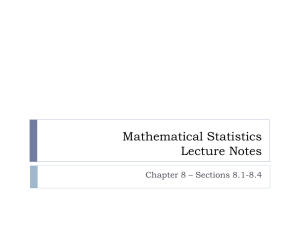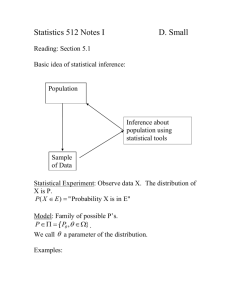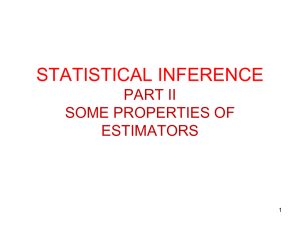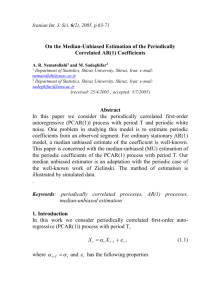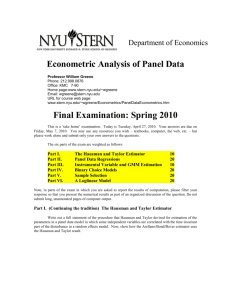Lecture 6
advertisement
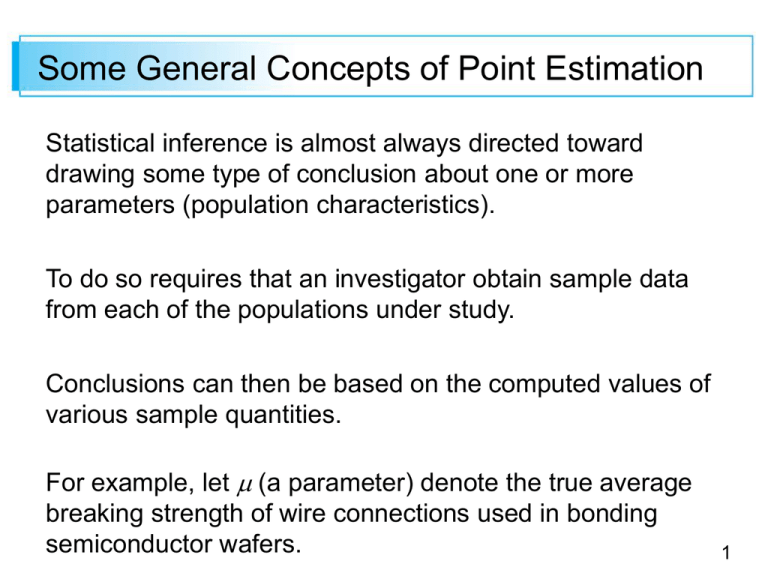
Some General Concepts of Point Estimation Statistical inference is almost always directed toward drawing some type of conclusion about one or more parameters (population characteristics). To do so requires that an investigator obtain sample data from each of the populations under study. Conclusions can then be based on the computed values of various sample quantities. For example, let (a parameter) denote the true average breaking strength of wire connections used in bonding semiconductor wafers. 1 Some General Concepts of Point Estimation A random sample of n = 10 connections might be made, and the breaking strength of each one determined, resulting in observed strengths x1, x2, . . . , x10. The sample mean breaking strength x could then be used to draw a conclusion about the value of . Similarly, if 2 is the variance of the breaking strength distribution (population variance, another parameter), the value of the sample variance s2 can be used to infer something about 2. 2 Some General Concepts of Point Estimation When discussing general concepts and methods of inference, it is convenient to have a generic symbol for the parameter of interest. We will use the Greek letter for this purpose. The objective of point estimation is to select a single number, based on sample data, that represents a sensible value for . Suppose, for example, that the parameter of interest is , the true average lifetime of batteries of a certain type. 3 Some General Concepts of Point Estimation A random sample of n = 3 batteries might yield observed lifetimes (hours) x1 = 5.0, x2 = 6.4, x3 = 5.9. The computed value of the sample mean lifetime is x = 5.77, and it is reasonable to regard 5.77 as a very plausible value of — our “best guess” for the value of based on the available sample information. Suppose we want to estimate a parameter of a single population (e.g., or ) based on a random sample of size n. 4 Some General Concepts of Point Estimation We know that before data is available, the sample observations must be considered random variables (rv’s) X1, X2, . . . , Xn. It follows that any function of the Xi ’s—that is, any statistic—such as the sample mean X or sample standard deviation S is also a random variable. The same is true if available data consists of more than one sample. For example, we can represent tensile strengths of m type 1 specimens and n type 2 specimens by X1, . . . , Xm and Y1, . . . , Yn, respectively. 5 Some General Concepts of Point Estimation The difference between the two sample mean strengths is X – Y, the natural statistic for making inferences about 1 – 2, the difference between the population mean strengths. Definition A point estimate of a parameter is a single number that can be regarded as a sensible value for . A point estimate is obtained by selecting a suitable statistic and computing its value from the given sample data. The selected statistic is called the point estimator of . 6 Some General Concepts of Point Estimation In the battery example just given, the estimator used to obtain the point estimate of was X, and the point estimate of was 5.77. If the three observed lifetimes had instead been x1 = 5.6, x2 = 4.5, and x3 = 6.1, use of the estimator X would have resulted in the estimate x = (5.6 + 4.5 + 6.1)/3 = 5.40. The symbol (“theta hat”) is customarily used to denote both the estimator of and the point estimate resulting from a given sample. 7 Some General Concepts of Point Estimation Thus = X is read as “the point estimator of is the sample mean X .” The statement “the point estimate of is 5.77” can be written concisely as = 5.77 . Notice that in writing = 72.5, there is no indication of how this point estimate was obtained (what statistic was used). It is recommended that both the estimator and the resulting estimate be reported. 8 Some General Concepts of Point Estimation In the best of all possible worlds, we could find an estimator for which = always. However, is a function of the sample Xi ’s, so it is a random variable. For some samples, will yield a value larger than , whereas for other samples will underestimate . If we write = + error of estimation then an accurate estimator would be one resulting in small estimation errors, so that estimated values will be near the true value. 9 Some General Concepts of Point Estimation A sensible way to quantify the idea of being close to is to consider the squared error ( )2. For some samples, will be quite close to and the resulting squared error will be near 0. Other samples may give values of far from , corresponding to very large squared errors. An omnibus measure of accuracy is the expected or mean square error MSE = E[( )2]. If a first estimator has smaller MSE than does a second, it is natural to say that the first estimator is the better one. 10 Some General Concepts of Point Estimation However, MSE will generally depend on the value of . What often happens is that one estimator will have a smaller MSE for some values of and a larger MSE for other values. Finding an estimator with the smallest MSE is typically not possible. One way out of this dilemma is to restrict attention just to estimators that have some specified desirable roperty and then find the best estimator in this restricted group. A popular property of this sort in the statistical community is unbiasedness. 11





